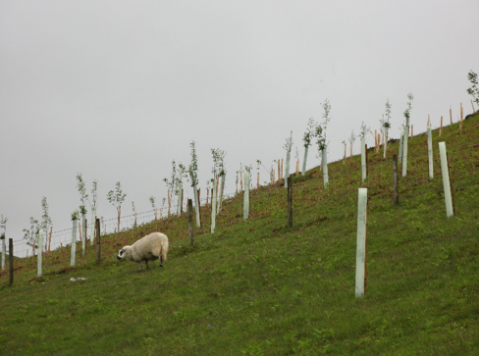Take home messages:
- Climate change offers an enormous challenge to UK agricultural systems
- Agriculture is a major contributor to greenhouse gas emissions, but could also offer opportunities to reduce the impact of climate change.
- Modifying current agricultural practice to mitigate the effects of climate change is therefore of immense importance.
Reducing the impact of climate change, by reducing the factors driving climate change, presents some major challenges for the UK agricultural industry. Agriculture, particularly livestock production, is currently a major contributor to greenhouse gas (GHG) emissions, but has the potential to reduce these emissions and even to remove carbon (C) from the atmosphere by increasing rates of sequestration in both vegetation and soil. Thus, modifying current approaches to land management could play a vital role in managing and reducing the future impact of environmental change.
Policy on climate change has primarily focussed on reductions in fossil fuel consumption, as this is a
significant driver of anthropogenic carbon dioxide (CO2) emissions. However, this alone is unlikely to be sufficient to ameliorate the impact of climate change. Agriculture may contribute significantly to GHG emissions globally, but is essential for food production. As global populations continue to increase, future demand for food production is predicted to grow by around 60% by 2050. For this reason, agricultural production systems must be developed which can increase output to provide for the growing population, whilst maximising opportunities to reduce current environmental impact and increase the potential for climate change mitigation.
GHG emissions
Reducing methane (CH4) and nitrous oxide (N2O) emissions from ruminant agricultural activities is of key importance to any climate change mitigation strategy. Methane is the second most abundant greenhouse gas after CO2, with a much stronger influence on radiative forcing and therefore the greenhouse effect (28 times greater than CO2). Reducing methane emissions could offer the best opportunity currently to
reduce the effect of radiative forcing on global climate, as this GHG has a much shorter lifespan than CO2 (~9 years), allowing for a more rapid response with regard to reductions in global warming potential. In addition, reducing methane emissions currently is important to limit future GHG influence, as increasing atmospheric concentrations of methane can act to enhance the lifespan of this GHG, and therefore its global warming potential.
Mitigation strategies designed to reduce GHG emissions focus on two sources: methane from livestock (from enteric fermentation) and methane and N2O emissions from manure. Enteric methane is the principal agricultural source of methane in Europe. This source can be reduced by modifying the diets of livestock. Strategies include rumen manipulation, adding dietary supplements or plant secondary metabolites to feed, or improving forage quality. Feeding stock forage material with lower fibre and higher soluble carbohydrate content, or the inclusion of legumes, has been shown to be effective at reducing methane emissions. In addition, the use of high sugar grasses can reduce enteric methane emissions by around 20%. Improved productivity through selective breeding may also play a role for future mitigation, as past selection of productive traits has resulted in reductions of GHG production at a rate of approximately 1% per year, by increasing efficiency. Therefore, the selection of dairy cows with high energy utilization efficiencies and milk productivity is an effective strategy for reducing enteric methane emissions.
Managing GHG emissions from manure can be achieved through improved infrastructure, such as covered slurry lagoons, or through the use of technology such as anaerobic digesters, which harvest the produced methane in a controlled environment for the purposes of energy production. Reducing the GHG emissions from manure can also be achieved through dietary manipulation. Reductions in the crude protein content of livestock diets are associated with lower faecal and urinary excretion of nitrogen (N), which may reduce emissions of N2O. Nitrous oxide emissions can be also be reduced from grassland by moderating the use of N as a fertiliser, by increasing the efficiency of the herbage of the sward to utilise N, by optimising timings for N fertiliser addition, by switching from nitrate to ammonium based fertilisers, and by employing chemical inhibitors of nitrification.
A limit to the number or proportion of ruminants in livestock agriculture has also been suggested as a mitigation strategy, as monogastric animals, such as pigs and chickens, produce considerably less methane. The GHG footprint for ruminant production is considerably higher than that of high protein plants (19 – 48 times greater) or monogastric animals (~4 times greater). In addition, relative to animal-based foods, plant-based foods (legumes) have considerably lower GHG emissions per gram of protein (~250 times less than ruminant meat). This is an important consideration in the current context, but demand for these products will dictate their production, so whilst demand remains constant (and in fact is predicted to increase) then grassland-livestock systems must be established which can minimise or negate impact.
Carbon storage
Soil is the largest terrestrial store of C, with a major role to play in climate change mitigation, both as a store of previously sequestered C and as a future sink of atmospheric GHGs. In general, the effect of climate change on soil C is complex. Increases in temperature will increase microbial activity, and thus decomposition rate and C loss, but this may be balanced by increased C inputs to soil from higher rates of net primary productivity (NPP).
Grasslands systems can store and sequester large amounts of C, however agricultural management intensity does have the potential to reduce current stocks and limit future sequestration potential. This effect has been observed recently to be considerable, at much greater depths than previously recognised. Management to augment soil C stocks will aim to minimise soil disturbance and erosion, maximise the amount of crop-residue returned to the soil, and improve water- and nutrient-use efficiencies during crop production. This can be achieved by reducing the frequency of ploughing or re-seeding, increasing the efficiency of animal manure usage, and maximising C returns from manure. The rate of nutrient input is also a key factor, as high rates of fertiliser addition could result in faster rates of decomposition.
Reducing management intensity can be a controversial proposal, as this is often associated with reductions in yield, and consequently, of economic potential. However, research has demonstrated that yields can be maintained by managing grasslands to increase plant species diversity, as productivity and diversity are positively related. Furthermore, this approach can reduce the need for fertiliser input and therefore production costs, whilst increasing on-farm biodiversity (both directly, by increasing floral species richness, and indirectly, by increasing the potential for associated fauna). This is extremely important currently, as biodiversity is essential for the future function of the agroecosystem and the delivery of ecosystem services, particularly given the challenges expected with climate change.
Improved soil management is a key mitigation strategy to increase below ground C storage, particularly for grassland systems. In addition to this, increasing aboveground C storage may also offer a viable mitigation strategy. Incorporating agroforestry into European grassland systems will result in an increase in the rate of CO2 sequestration. This amount of C can be substantial despite the small area of land required by agroforestry (e.g., approximately 3% of a field for crop/livestock windbreaks) due to the high rates of C sequestered per unit area. This approach may also offer additional benefits in terms of livestock and soil management.
Land use change
The conversion of land for agriculture can have significant influence on GHG emissions. In the UK, the
conversion from peatland to arable or grassland can release huge amounts of CO2 to the atmosphere. In the developing world, the conversion of virgin forest, particularly neo-tropical forests, releases huge amounts of CO2, both from lost vegetation and from the disturbance to tropical forest soil, which is rich in organic matter. Such deforestation is driven in part by demand from western countries for high protein animal feed such as soy bean meal. Thus, by increasing the availability of home grown supplies, this demand (and consequently the loss of these natural resources) will reduce. This approach is also important for future food security in Europe, as reliance on foreign sources of animal feed needs to be reduced.
Livestock production system transitions, which refers to shift towards mixed crop-livestock systems, are typically considered as an adaptation tool to manage the impacts of climate change, however this system has also been demonstrated as a mitigation tool by allowing sustainable intensification, whilst reducing GHG emissions and the demand for conversion of natural land. This approach can lead to substantial GHG emission reductions, primarily through avoiding necessary future land-use change, but also by switching livestock diet composition to include more cereal content, as there is a higher methane output from forages when compared to cereal based systems. In addition, this approach represents a smaller cost burden in terms of expense of adaptation to climate change, which may aid the uptake of such approaches by agricultural businesses.
Summary
Reducing the contribution of current agricultural activities to climate change, and increasing
the implementation of management practices that can reduce the effects of this environmental change, are of critical importance.
Approaches that offer an integrated approach to multiple challenges are key mitigation strategies, as multiple goals can be achieved simultaneously. This is demonstrated in the example of agroforestry above, where greater provision of tree cover could increase atmospheric C sequestration, reduce heat stress in livestock, improve soil management and reduce the potential for flood events,. Such relatively uncomplicated modifications to land management could increase agroecosystem resilience to environmental change, whilst delivering necessary mitigation and adaptation measures. This therefore offers a scenario whereby a single change in the approach to management can deliver multiple on-farm benefits.



